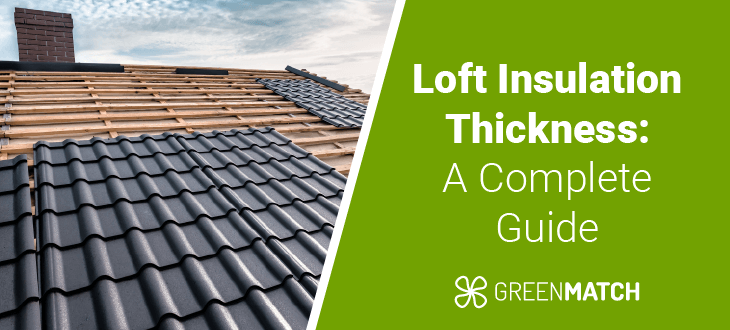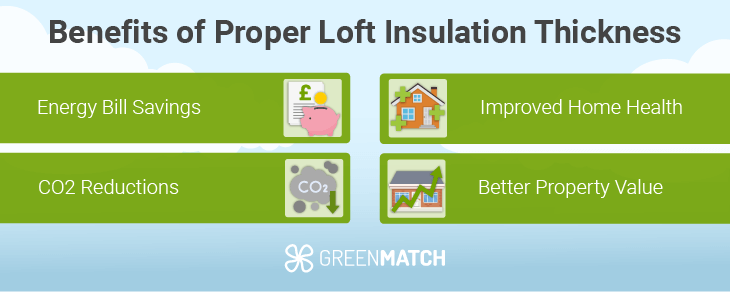Answer these simple questions and we will find you the BEST prices
Which type of solar quotes do you need?
It only takes 30 seconds
100% free with no obligation

Get Free quotes from insulation specialists near you

Save money by comparing quotes and choosing the most competitive offer

The service is 100% free and with no obligation
- GreenMatch
- Insulation
- Loft Insulation
- Loft Thickness
What Is the Ideal Loft Insulation Thickness? (2025)


- According to Part L of the UK Building Regulations, loft insulation thickness should be at least 270mm of mineral wool or similar blanket-style insulation.
- Uninsulated lofts are responsible for up to 26% of heat loss in a home, leading to soaring energy bills, and a damp drafty home environment.
- Loft insulation can bring up to £380 in annual energy savings to a detached UK home.
Loft and roof insulation are some of the most budget-friendly and effective home efficiency upgrades. Reducing home heat loss by over a quarter, roof and loft insulation brings significant energy bill savings, reduces condensation and mould, improves your property value, and even slashes your domestic carbon footprint.
Better yet, loft insulation has one of the quickest payback periods for any insulation project, normally able to pay itself off within 5 years. With the wealth of benefits to be enjoyed, it’s important to note that the UK has roof insulation building regs in place to ensure the job is done right. Therefore you may be wondering; how thick should loft insulation be?
This complete guide by GreenMatch UK will delve into all things loft insulation thickness, providing a guideline of loft insulation requirements, how deep should loft insulation be, and how to determine the right materials.
Ready to insulate your loft? Look no further than GreenMatch UK for all your needs. Save endless hours of research and vetting by just spending 30 seconds filling out our online form. In return, receive up to 3 free home-tailored quotes directly from our nationwide network of pre-vetter professionals. No charges or obligations. Simply click below to begin!
- Describe your needs
- Get free quotes
- Choose the best offer
It only takes 30 seconds



How thick should loft insulation be in the UK?
If you wonder how much loft insulation you need, you're in the right place. Building regulations for roof insulation thickness recommend a minimum loft insulation thickness of 270mm mineral wool to achieve the desired u-value of 0.16 W/m²K. Achieving this u-value will ensure your loft insulation is as thermally efficient as can be.
Alternatively, rigid insulation boards such as PIR or corkboard are more thermally efficient, meaning you require a loft insulation depth of about 120mm to achieve the same u-value.
A u-value is a numerical measurement of the rate of heat transfer of a material. In other words, the u-value tells us the rate at which heat can pass through a material. This means that the lower the u-value, the better a material is at resisting heat transfer.
Alongside loft insulation guidelines, there are other factors to consider, such as your choice of cold or warm loft insulation. This in turn can influence your material choices and the approach by which you achieve the needed thickness. Let’s take a look at the differences:
- Warm loft insulation is when insulation material is laid in between and above the roof rafters, incorporating the roof structure into the thermal envelope. This approach is ideal for homes that plan to use their loft as a living space. Warm roof insulation thickness should be 170mm of blanket-style insulation on top of the roof rafters with a vapour barrier, along with a further 100mm of rigid board insulation between the rafters.
- Cold roof insulation is when insulation material is laid in between and under the floor joists of your loft space, leaving the loft and roof structure uninsulated. This approach may be more affordable but is more suited to homes that will leave their lofts unused, or as storage. Install 270mm of mineral wool directly in between and under the floor joists, secure it in place and cover with plasterboard for a clean finish.
To better understand how your choice of insulation material can affect the thickness of loft insulation you need, we’ve summarised some popular insulation materials along with the desired thickness:
| Insulation material | U-value range (W/m²K) | Estimated thickness (mm) |
|---|---|---|
| Mineral wool | 0.030 - 0.040 | 270mm |
| Cellulose | 0.036 - 0.042 | 270mm |
| PIR Board | 0.022 - 0.028 | 120mm |
The depth of loft insulation you need mainly hinges on the u-value you are trying to achieve, as demanded by building regulations in the UK. Therefore, you may need more or less thickness depending on your real-life case.
Still wondering; how much loft insulation do I need? It's best to work with a professional installer who can assess your loft and provide the best course of action to achieve the desired u-value.
Loft insulation thickness for newly built homes
Generally, UK Building Regulations require an even lower u-value for new builds, as these properties have the potential to achieve better thermal efficiency than older builds. New-built lofts need to achieve a u-value of 0.11 W/m²K, which requires a loft insulation minimum thickness tailored to your material choice.
This doesn’t necessarily mean that the insulation material needs to be overly thick, but can sometimes be achieved in a newly built loft due to the pristine condition of construction and material, with fewer air gaps and damage to account for.
Nevertheless, here’s a breakdown of the general material thickness needed to achieve this desired u-value:
| Insulation material | U-value range (W/m²K) | Estimated thickness (mm) |
|---|---|---|
| Mineral wool | 0.030 - 0.040 | 250mm - 270mm |
| Cellulose | 0.036 - 0.042 | 300mm |
| PIR Board | 0.022 - 0.028 | 130mm - 150mm |
Ultimately, working with a professional installer will give you the best course of action tailored to your property and its conditions.
How does insulation thickness vary between flat and pitched roofs?
Flat roof and pitched roof insulation thickness can have differences in achieving the intended u-value. Generally speaking, the u-value expectations remain the same, but several factors can impact the method of insulation used to achieve them:
- Structural build: For starters, pitched and flat roofs have different structural builds, meaning that insulation is installed in different manners to accommodate the shape, material and layers present in each roof type.
- Surface area: Flat roofs and pitched roofs have different surface areas, meaning heat loss through the roof occurs in different ways. Therefore when insulating, different approaches are employed to combat heat loss.
- Type of insulation: Pitched and flat roofs can both accommodate warm or cold roof insulation, although the methods of application differ.
Can loft insulation be too thick? Ultimately, the thickness of the insulation material required hinges more on the actual efficiency of your chosen insulation material, but other factors such as roof type, condition and size can play a significant role in determining how much insulation thickness you need for desired results.
Working with a professional installer can ensure that you make the right decisions suited to your circumstances. However, finding the right installer at a bargain can take endless hours of stressful researching and vetting. Luckily, GreenMatch UK can take care of this for you.
Simply spend 30 seconds filling out our online form, and receive up to 3 free home-tailored quotes straight from our nationwide network of professionals. No charges or obligations apply. Click below to begin!
- Describe your needs
- Get free quotes
- Choose the best offer
It only takes 30 seconds



Why selecting the right loft insulation thickness is important

Selecting the right loft insulation thickness is important, as it’s the main factor that helps achieve the highest thermal efficiency for your loft and property.
If under-insulated, your property will fall short of achieving the highest home comfort, energy bill savings, carbon cuts and property value. However, thick loft insulation allows you to enjoy these benefits and much more:
- Energy bill savings: Proper loft insulation can cut more than a quarter of home heat loss, leading to £380 in annual energy bill savings in a standard detached UK home.
- CO2 reductions: Thorough loft insulation in a detached home can cut your domestic carbon footprint by a staggering 1 ton a year, creating a much healthier home and surrounding environment.
- Improved home health: Homes with proper thermal enveloping suffer less from condensation, mould, and structural rot. Not only does this prolong your home’s health, but also your well-being by reducing the risk of respiratory disease.
- Better property value: Homes with thorough insulation measures in place are valued higher in the housing market. This means your home will attract more attention and capital, should you ever plan to rent or sell your home.
All in all, selecting the right loft insulation thickness is a key factor in ensuring decades of home thermal comfort and a wealth of benefits.
How to determine the right insulation thickness for your loft
Determining the right insulation thickness for your loft requires the analysis of a combination of factors, including your home’s structural build, type of roof, chosen insulation material, outstanding repairs and much more.
Therefore, it’s best to work with a professional roofing contractor who can assess your property and provide the most effective course of action for long-term loft insulation. Sadly, finding the right installer at the right bargain can feel like looking for a needle in a haystack. Most prospective customers find themselves stuck on endless websites and phone calls with no bargain in sight. Luckily, GreenMatch UK can change that.
By spending just 30 seconds to fill out our simple online form, you can get ahead of the game with 3 free home-tailored quotes directly from our nationwide network of pre-vetter professionals. The best part? Our services are completely free. Click below to begin!
- Describe your needs
- Get free quotes
- Choose the best offer
It only takes 30 seconds



FAQ
The recommended UK loft insulation thickness is around 270mm of mineral wool or other similar blanket-style insulation. This is suggested to achieve a u-value of 0.16 W/m²K, the expected thermal efficiency for existing dwellings and extensions.
400mm of roof insulation is considered beyond what is needed to achieve the desired u-value for proper thermal efficiency. Some materials such as PIR board can achieve sufficient thermal efficiency with even less thickness, but it’s generally recommended to install a minimum thickness of loft insulation at around 270mm.
200mm of roof insulation generally falls short of what is needed to achieve the intended u-value ranges set out by UK building regulations. Some materials such as PIR board have a higher thermal efficiency, meaning you can use around 120mm of insulation to achieve what 270mm of mineral wool insulation would achieve.

Akif is a copywriter at GreenMatch since 2023. With a keen interest in community sustainability, green solutions and the role of digital media in identifying climate trends, he aims to hone in on his background in International Studies and Digital Media to provide a multidisciplinary approach to written content rooted in credible research and accuracy.
We strive to connect our customers with the right product and supplier. Would you like to be part of GreenMatch?

- What Is the Ideal Roof Insulation Thickness? (2025)
- How thick should roof insulation be in the UK?
- Roof insulation thickness for newly built homes
- How does insulation thickness vary between flat and pitched roofs?
- Why selecting the right roof insulation thickness is important
- How to determine the right insulation thickness for your roof
- FAQ
